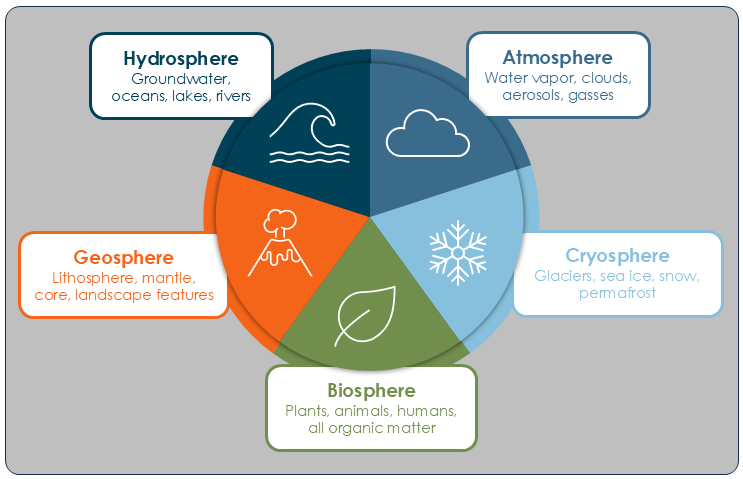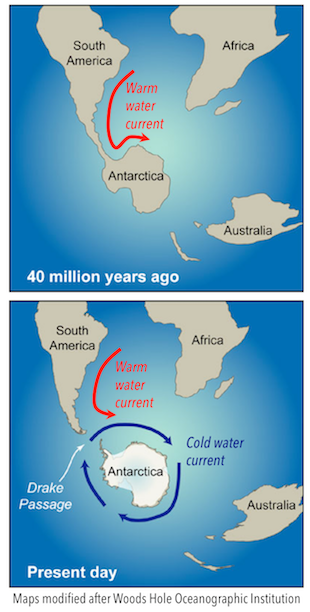1. Earth as a System
Earth can be characterized as a system of interacting “spheres.” The atmosphere is the envelope of gas surrounding the planet. The hydrosphere is the liquid water on the planet, whether in oceans, rivers, glaciers, or the ground. The biosphere comprises all living organisms and any undecomposed organic matter. The geosphere is the rocky portion of Earth from surface landscape features down to the core. The cryosphere is the frozen parts of the planet such as glaciers, snow, sea ice, and permafrost (Figure 3A.1.1).

The individual pieces within the spheres are termed components. For example, components of the cryosphere would be glaciers, snow, sea ice, etc. Components of the spheres interact constantly, with processes occurring in one sphere having an impact in other spheres. Cycles such as the water cycle or the carbon cycle constantly move matter and energy between spheres. Taking an Earth-Systems approach—looking at how the spheres are connected—is a way to account for the web of interactions responsible for the “big picture” of the Earth that we know.

A good example of why a system of interactions is needed to understand how Earth works is the climate change related to the opening of the Drake Passage (Figure 3A.1.2). The Drake Passage is the gap between the southern-most tip of South America and Antarctica (bottom map), but prior to 40 million years ago, the Drake Passage did not exist (top map), and neither did the Antarctic ice cap. The arm of land connecting South America and Antarctica allowed warm ocean currents (red arrows) to carry heat from the equator to Antarctica. When the gap opened, a new cold-water current, the Antarctic Circumpolar Current, formed (blue arrows). This current flows in a continuous loop around Antarctica and blocks warm water from reaching Antarctica. Without the influx of heat brought to Antarctica from the equator in that warm water current, ice sheets began forming on Antarctica.
There were many interconnecting processes within the Earth-system that drove glaciation in Antarctica. In the following explanation, spheres will be underlined and components within the spheres will be italicized to help clarify how these are connected.
First, heat energy within Earth drove plate tectonics (geosphere), making it possible for South America to separate from Antarctica. This impacted ocean currents (hydrosphere), and ultimately how water was stored on Antarctica (hydrosphere and cryosphere) by changing the climate of Antarctica.
As the climate of Antarctica cooled, this altered both rainfall (hydrosphere) and snowfall (cryosphere) patterns and changed habitats (biosphere) there. As habitats cooled, organisms either adapted, died off, or migrated to more suitable locations.
This chain of events is only a broad overview of the consequences of a gap opening between South America and Antarctica. For example, it could go further and include what changing the types of plants in a location does to local weathering and erosion. Trees growing along a riverbank might slow the rate of erosion as their roots help hold soil in place. This would reduce the amount of sediment in the river and decrease how much sediment is supplied to a delta. If this sediment supply is lowered, it may mean parts of the delta are more prone to flooding, changing the extent of wetlands which play an important role in keeping carbon dioxide out of the atmosphere. This train of thought could continue, but you get the idea.
The short version is it is important to look at Earth as a system because everything is connected. A change in one part of the system can ripple through the rest of the system and have effects well beyond any one location or time.
Check your understanding: Earth Systems
